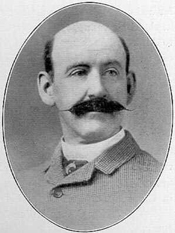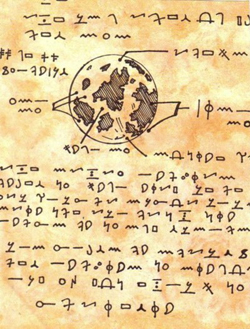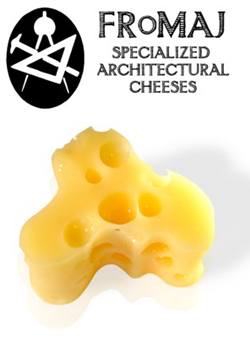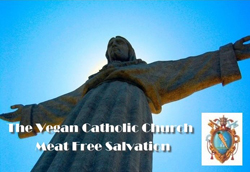by Dr. Scott Birdseye
Religion of The Chanjrinites

Dr. Scott Birdseye is a globally recognized expert on Sumerian pottery. His most recent work Rock Singer Shirley Manson and Sumerian Pottery: A Global Perspective has been on the New York Times Bestseller List for a record three thousand eight hundred and twenty seven weeks.
From the Morthis Passage in the west, on the far end of the gently sweeping plains of Yahm, to the Phlenian Sea in the east, below the high cliffs of the plateau of the Plenne, to the high mountains which rise in the north as a wall against the barbarians, across the whole of our realm, in every village and town, despite the different people, languages and nations, there exists one common thread which unites us all; the reverence held toward Chanjrina.
Belief in Chanjrina is as old as the most venerable records of yore, spoken of even in the first carvings on the Monoliths of Traal in the ancient valley of Mistipuck. Throughout the land, in their own individual ways, differing slightly from tribe to tribe, the people hold tightly to their beliefs in the same Gods, those mighty heroes of Chanjrina.
The religion of Chanjrina is a complicated belief system incorporating thousands of different views into one common system. In each tribe different Gods are worshiped, different texts are read, and different artifacts are held sacred, but the basic tenets of the religion hold true throughout the realm. Family, virtue, the sacred Laws laid down in the Text of Horrus Pollus, the Gods of Chanjrina, and belief in the ultimate underlying force of Primah, are the most important elements which unify the diverse belief systems.

Above: One of the few remaining fragments of the sacred Wisdom of Horace Pollus. Courtesy of the British Museum.
Family is the most important thing in daily life, but family includes not only our immediate relatives. There are many intricate levels of family, but six basic1. The first is Rahsah, meaning immediate family, brothers, sisters, children, mothers and fathers. The next level is Doesah, the extended family, grandparents, cousins, aunts and uncles. The third, Kihsah, is the clan, the large group encompassing several doesah, interconnected by marriage. Fahsah is the family of the village, the group which makes up a single geographical area. Swaksah is the nation, the group comprised by those who share common language, history and sometimes government. Neipesah is the highest level of family, the family of humanity, where the Gods are recognized as the parents, and all people in the world are their children.
The overall concept of family, is called Sah Ephisi’utt, and in each level of family there are both respects which must be paid and obligations which must be performed. In the same way that a father loves his child, or that the Gods look after the people, so must a ruler look after his subjects. And in the same way children must obey their father, so must the people obey their rulers and Gods. There is a reciprocal idea, where duty and trust coexist.
Within this duty and trust exist the virtues which must be followed and the sins which must be avoided. The Sacred Texts of Horrus Pollus describe the important aspects of living a life a virtue and tell how all people, great and small, free and slave, rich and poor, must do their best to honor all their families. The texts tell of The Twelve Defilements, or evil actions, which must be not be performed if one is to properly respect all others.

The Twelve Defilements are Untruthfulness, which includes both lying and hypocrisy; Dishonor, showing a lack of respect to all levels of familial obligation; Cowardice, failure to do what is right regardless of personal cost, both in battle and in daily life; Idleness, the failure to work and to help others; Cruelty, mistreating those below you; Murder, the killing of another person without holy sanction; Cannibalism, eating the flesh of another person, or taking of trophies of those killed in war; Thievery, taking goods that don’t belong to you, or cheating others in trade; Greed, putting money and possessions above familial responsibility and duty; Maliciousness, treating animals badly; Haughtiness, putting one’s own interests above the interests of the families; and Irreverence, destroying, defiling, or stealing sacred objects, holy relics, temples or other objects of worship.
The Twelve Defilements are just one part of the sacred Texts of Horrus Pollus, the holy book which lays down the principals of the religion of Chanjrina. Though ancient and now shrouded in mystery, tradition tells that Horrus Pollus began his life as a poor and humble shepherd in the land outside the city of Fara in the valley of the river Arexarr. One night while Horrus was meditating on the meaning of life, a traveler came upon him. The traveler asked him what he was doing, and Horrus told him that he was trying to figure out how to lead a good life and be a proper person.
Asking Horrus to follow him to a high hill nearby, the traveler led him to a tree on the top. There, under the tree, Horrus found an empty book which he picked up. The traveler asked him to write down what he was told. Horrus explained that he could neither read nor write, but the traveler urged him to try. Reluctantly, Horrus set the stylus to the paper, and as the traveler spoke, Horrus found that he could write. The traveler laid down the secrets of Chanjrina and Horrus wrote them.
As down approached, Horrus wrote down the last word and looked up to see that the traveler was no more. Standing in his place, was Soggib, the God of Life. Horrus prostrated himself, but Soggib told him to get up and then told him that it was his calling to teach the message of the book that is now known as the Text of Horrus Pollus.
The Text not only explains the importance of virtue in life, but it also imparts the Holy Law, tells the stories of the Gods, and explains how the world came into being. Throughout the ages since, the Text has remained an important part of daily life throughout the realm, and its Holy Law forms not only the basis for all written codes of law throughout the realm, but also describes in detail what the individual must do in his or her life.
In all there are six hundred individual commandments within the Holy Law, including rules for trade, guidelines for criminal punishment and trial, and standards for diet and food preparation. Some of the key elements of the Holy Law are it that must be applied to all people throughout the world equally, without regard to social status, and that punishments must always be fair; a cow for a cow, a coin for a coin.
The Holy Law also declares that all people must celebrate two Holy Days during the year: Feast of Allemechnich and Necropacia. Allemechnich, the celebration of the new year, takes place on the summer solstice; the longest day of the year. The day requires a feast of food and wine, and at each table, an extra place must be set for Kourbloh, the God of Change. The second holy day is Necropacia; the Day of the Dead, which takes place in the middle of the month of Desh, at the end of winter. A sacrifice must be made to Aramay; the Goddess of Justice, on behalf of the dead. If Aramay is not pleased, then spring will not come, and the land will be trapped in eternal winter.
The Text of Horrus Pollus also tells of Chanjrina, the realm beyond the Pillars of Twangos which hold up the sky, where the Gods reside. Chanjrina is the home of the gods, a ringed city on the River Crauneus centered on Midge, the home of the gods. On the first ring out lies the Garden of Souls, the dwelling place of the Most Holy and Sacred Stone of Ages, called the Ulyannin. A Living Ghost (dead person) who is worthy can go unto the Ulyannin and take it in their hands. If they are worthy, then their identity is joined forever with Primah, the Most Holy Force and they become one with the Eternal Wind. On the second ring lies the home of the Living Ghosts, a palatial residence for those souls who are worthy. The palace is next to the Forrest of Eterna, where lives The Tree Polistiss, which grew from the hair of The Mother before the world was. On the Outring lies the House of Judgement, where all go to be judged worthy before entering Chanjrina. Upon each person’s entrance into the House of Judgement, they are charged by the Council of Gods to perform a task or feat. If they can, they are admitted to Chanjrina, if not, they can never enter the Holy City. The feats are sometimes as simple as saying a prayer of praise, and can sometimes be as trying as defeating a God in combat. The difficulty of the task is set forth according to the virtue of the person in question.

In this holy city live the Gods. Though each village, tribe and city worship different Gods, each has its own patron God. There are also other Gods who are more universal, such as Soggib God of Life, Lazner God of Destruction, Elek the God of Trade, Akan the God of War, Nettumayu the Goddess of Harvest, Leyoto God of the Moon and Auralla the Goddess of Wine. Karnus and Caranna are the King and Queen of the Gods, mother and father of all other Gods, and rulers of all creation.
Soggib and Lazner, the two oldest sons of Karnus and Caranna, are the creators of the two realms which came after Chanjrina. Soggib, created Pall, our world, and Lazner created Ab the pit of fire.
Early in time, soon after the Primah brought the universe into existence, Soggib and Lazner sat bored beside the River Crauneus. After sitting for a while, their minds idle, Lazner, the elder of the brothers, devised a contest to entertain them. Each would use their powers, life and destruction, to create a new realm like Chanjrina. They would have their sister Zir the Goddess of Knowledge judge both worlds, and whoever’s world she chose, would be judged as the most powerful and best.
So Soggib brought forth the sea and in it he put a large island. He took his hands and shaped the rock, making hills and valleys, canyons and rivers and plains. Then he knelt down on the rock and breathed on it and his breath turned the rock green. The color soon spread, until it covered the whole island. The green then grew up and became the grass and the trees and all the plants which covered the land. Picking up a hand full of dust, Lazner threw it over the land. Then he clapped his hands, and the dust which was on the ground instantly became all the animals, and the dust which fell into the sea instantly became all the fish, and that which was still floating in the air became the birds. And the sun warmed the island and the sea and Lazner was happy. He called the realm Pall.
Lazner, God of Destruction, saw Pall and was not pleased. So, he went deep into the Eternal Rock and made a deep cave, and from the primordial fire therein created a vast sea of flames. He breathed his cold breathe upon the fire and turned it into bone, creating a high mountain which rose above the sea of flame inside the deep pit. Taking his staff, Lazner brought it down upon the bone mountain and split it into thirteen parts. The center shard became a steep pillar, upon which Lazner brought forth a fortress of bone to be the capital of his abyss. The twelve other shards became towers rising from the sea, and within the towers were dungeons. Lazner took up a cup full of the fire and tossed it onto the bone where each drop became a Tormentor, a vicious creature of a horrid nature. The Tormentors went unto the fortress and the twelve dungeons and made them their home. He called the realm Ab.
Zir then looked out upon the two worlds and in her infinite wisdom decided that Soggib’s world was best and so she declared him the most powerful and best. This sent Lazner into a jealous rage and so he vowed to destroy his brother Soggib. Fearful, Soggib fled Chanjrina and went unto his world, Pall. To hide himself from Lazner’s wrath he created a race of animals who had the appearance, mannerisms and speech of the gods, but who were mortal and had no powers. As they built their farms and cities, Soggib hid among them, tilling the fields by their side and pretending to be one of them. Lazner, seeing the multitude of people, could not find Soggib, so he declared that he would find him one day and until then would cause pain and destruction to rain down on the inhabitance of Pall.
Hearing this, Caranna, the Mother of all the Gods, cast Lazner out of Chanjrina for all time and sent him to rule over his own world. She declared that all the humans who were evil during their lives would be sent to Ab after their judgement and it would be Lazner’s responsibility to see that they were punished. And so, Lazner went unto Ab, but told his Tormentors to rule over it and take control of his responsibility for the Damned Ghosts, and he escaped into Pall, where he hides, secretly working to bring more pain and death into our world.
Lazner and Soggib, though seemingly opposite, good and evil, are both actually, according to the Chanjrina religion, a part of Primah, the basic life force in the universe. The text of Horrus Pollus tells of Primah, and how in the beginning of time, Primah was broken apart into the Eight Traces (air, wood, rock, bone, fire, flesh, water, and blood) to form everything in our universe. Though Primah became broken, every piece still remains connected in some way, thus all of the universe, every part is related to another part and together they still form the whole of Primah.
In the beginning, before time; all was dark, until there first appeared the spark of Primah. The spark breathed out and wrought forth the Eternal Wind. The spark was then breathed upon by the Eternal Wind. And the Eternal Wind spiraled around the spark until the spark became a bright fire which lit up the empty darkness.
Smoke rose from the fire. As it traveled farther and farther away from the fire the cold emptiness came around it, the smoke froze and hardened into solid rock. More smoke came, and it too formed into rock until the rock surrounded the fire and sealed it up. Thus it became the Eternal Rock.
The Eternal Wind blew over the rock and blew bits of sand off of the rock and the sand fell into a pit. The pit was deep and close to the fire. The fire heated the sand until the it became a form. Thus was born The Mother.
The Mother was trapped in the deep pit and could not get out. So she took a piece of rock and pierced her heart until the blood flowed up and filled the pit. And the blood became water which flowed through the gorges of the rock and became the River Crauneus.
The Mother’s body fell by the side of the river where the water reached up to her, lapping her body. Her dying breath joined with the Eternal Wind and brought it down to the surface of the rock where it would dwell always, never again to chill the dark emptiness. Forever would the Eternal Wind flow about the rock that formed the universe.
The water from the river came to The Mother’s body. Her eyes came up above the rock and became the sun and the moon which would always watch over the rock. And the eyes saw how beautiful the rock was against the darkness and so they wept tears of joy. The moon’s tears became the stars, and the sun’s tears became the clouds.
The Mother’s hair grew into the Tree Polistiss, which still grows next to the river. The tree swayed in the wind, which also blew the sun and moon around on their courses. The Mother’s flesh and bone then split apart, and the flesh became Caranna and the bone became Karnus. Caranna and Karnus were breathed upon by the Eternal Wind and became alive. They joined together their flesh and bone into two sons, Soggib and Lazner.
And the Tree Polistiss bore fruit which fell into the river and became the Messengers, the servants of the Gods. The Messengers went unto the rock and from it built Midge, a holy palace for Karnus and Caranna. So, the king and queen of the Gods went into their home and looked out over the bare rock through which the river flowed. They were displeased, and so they built gardens and forests upon rings in the river and named their city Chanjrina. Karnus and Caranna then went unto their palace to bring forth their children, who would be all the Gods. Thus were brought forth the Eight Traces of the Primah; wind, fire, rock, water, blood, flesh, bone and wood.
And so, as Lazner and Soggib went unto the river to idle the first day away, our world came into existence. And so Soggib went unto our kind to hide from Lazner’s wrath. And Soggib searched the realm of Pall until he found a truly selfless and virtuous man, Horrus Pollus, to whom he gave the sacred knowledge which today forms one of the important fundamentals of the religion of Chanjrina, which was to spread throughout the entire realm, with its teachings and beliefs on virtue, the importance of family and familial obligations, all founded on the principals of the Primah.


I love this product how can I order more?